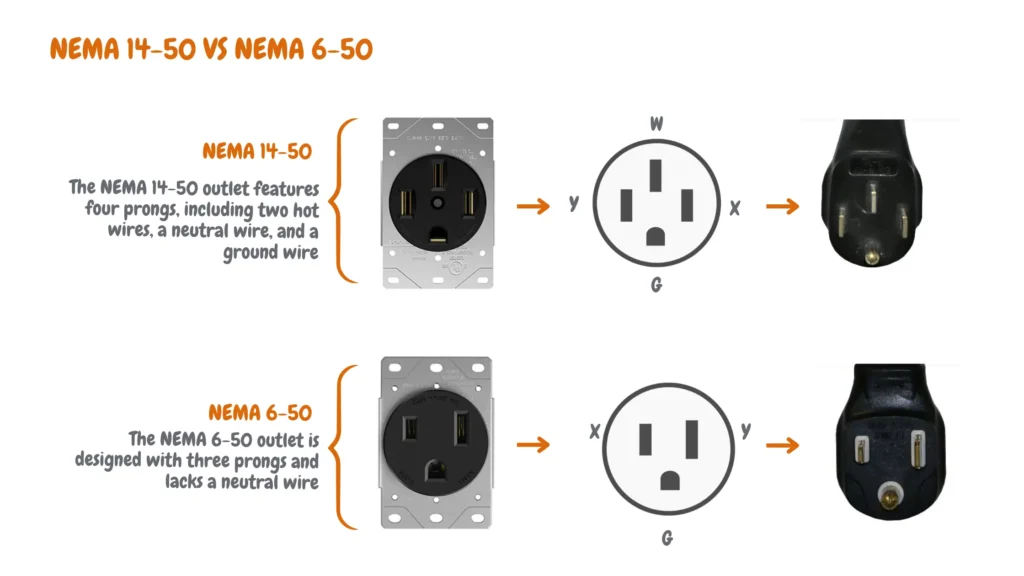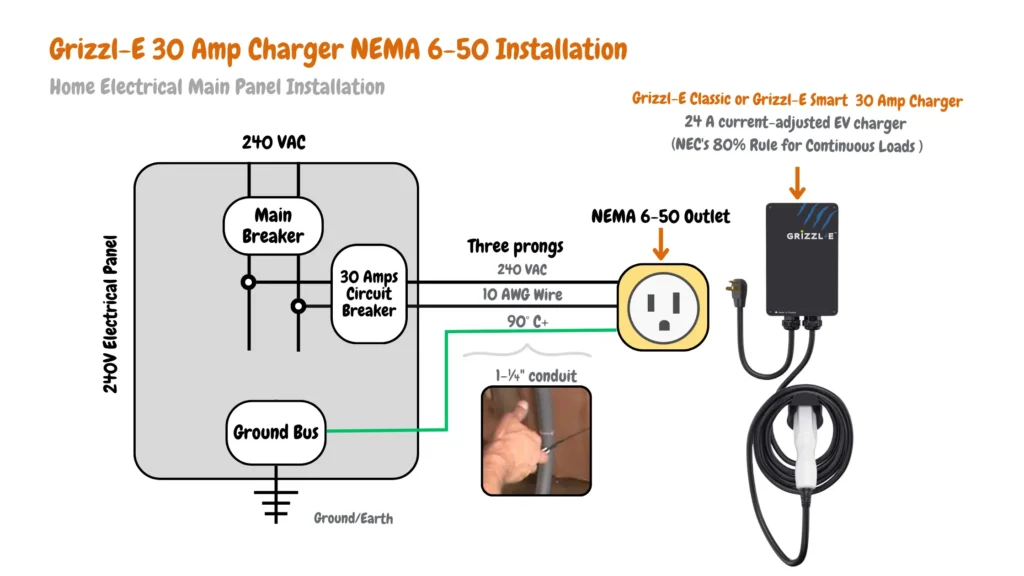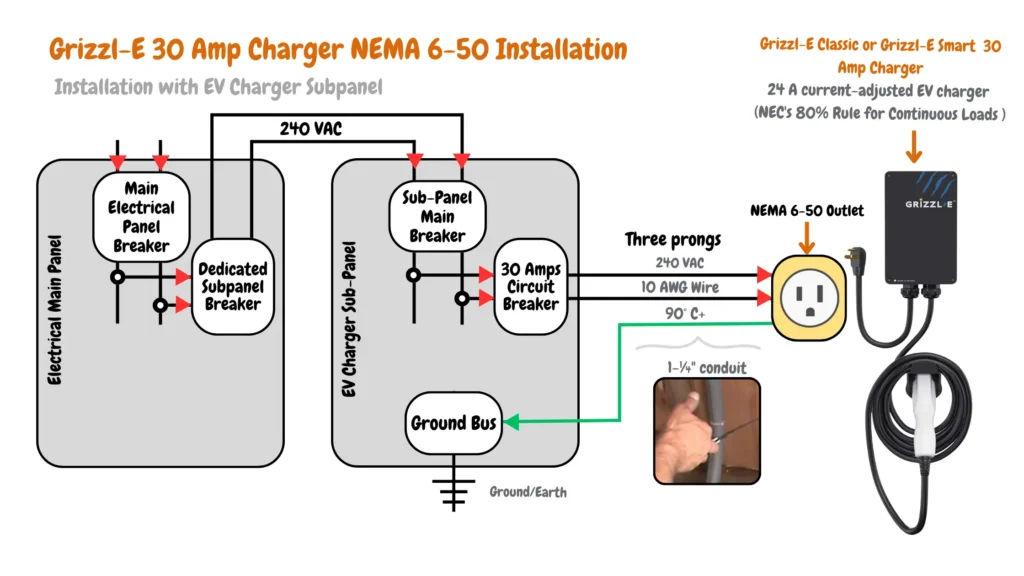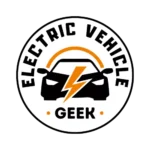This guide lists the best 30-amp electric car chargers and how to install them in your home, a level 2 30-amp charger should be installed with a dedicated 30 amps circuit breaker, If you have a standard 30-amp electric vehicle branch circuit for EV charging, the 80% rule outlined in the National Electrical Code (NEC) for continuous loads like electric vehicle (EV) charging dictates that the 30-amp electric car charger shouldn’t exceed 80% of 30 amps (0.8 x 30 amps) = 24 amps.
A 30-amp electric car charger Level 2 EV charger can be a plug-in EV charger installed with a NEMA 14-30 or a NEMA 14-50 Outlet, it can also be a hardwired Level 2 EV charger depending on your installation choices and the charger specifications.
Depending on your home’s electrical supply, you can use a 240V 30-amp single-pole breaker or a 240V 30-amp double-pole breaker which is designed to handle a maximum of 30 amps, when the current of the Level 2 EV charger exceeds 30 amps the EV charger breaker trips, interrupting the flow of electricity in the electric vehicle branch circuit to protect your home electrical system from damage and electric vehicle charging fires.
According to the National Electrical Code (NEC) guidelines, a circuit cannot be loaded beyond 80% of its capacity. This is to prevent overheating and potential fire hazards. Therefore, on a 30 amp circuit, the usable amperage for continuous charging we used to test all the chargers in this review was 24 amps (30 amps * 80%).
This translates to a maximum charging rate of around 5.8 kW. While this might be slightly less than the 7.2 kW achievable if ignoring NEC rules, it ensures safe operation within the recommended parameters. Testing this 30-amp electric car charger added approximately 17-20 miles of range per hour, a significant improvement over a standard 110v outlet. The trade-off is a slightly slower charging speed for guaranteed safety compliance.
The diagram below shows a typical electric vehicle branch circuit of a 30-amp electric car charger connected with a 10-gauge wire to a dedicated 30-amp circuit breaker enclosed in a 240V electrical panel.

Table of Contents
- Key Take Aways
- Best 30 Amp Electric Car Charger Review
- Grizzl-E Classic Level 2 EV Charger
- Home Flex Hardwired Level 2 EV Charger
- Best Tesla 30 Amp Charger
Key Take Aways
Best 30 Amp Electric Car Charger List
Best Tesla 30 Amp Charger List
Best 30 Amp Electric Car Charger Review
Outlined below are the top 30-amp electric car chargers that adhere to NEC regulations, (all typically 24-amp output)
Grizzl-E Classic Level 2 EV Charger
Our #1 recommended 30 amp electric car charger is the Grizzl-E Classic Level 2 EV Charger, it’s our number #1 30 amp electric car charger for its budget-friendly prices, ease of installation, and functional features compared to our #2 30 amp electric car charger the Home Flex Hardwired Level 2 EV Charger.
As an EV charging expert, I can tell you the Grizzl-E Classic Level 2 EV charger stands out for those seeking a safe and versatile option on a 30 amp circuit. It prioritizes safety with UL Listing and built-in protections against electrical faults, overheating, and even ground faults thanks to the GFCI.
The durable build ensures it can withstand the elements and minor bumps. But it’s not all brawn – the adjustable current lets you perfectly match the charger’s output to your circuit’s capacity, ensuring you never overload it.
Unfortunately, the Grizzl-E Classic is not a smart charger. While it offers many great features for simple EV charging, it lacks the ability to connect to Wi-Fi or an App. This means you won’t be able to remotely monitor your EV charging status, schedule charging sessions, or integrate it with smart home systems.
Grizzl-E does offer a separate model called the Grizzl-E Smart that provides all features of the Classic charger plus smart EV charging features that the Grizzl-E lacks.
The best choice between the Grizzl-E Classic and Grizzl-E Smart charger depends on your needs and priorities. If you just need a simple and reliable 30-amp EV charger, the Grizzl-E Classic is a great option. But if you value smart features and remote control on a 30-amp circuit, the Grizzl-E Smart might be worth the extra investment.
Grizzl-E Level 2 EV Charger 30 Amp Charger Installation
The Grizzl-E Classic and Grizzl-E Smart shine for their easy installation on a 30 amp circuit compared to the Home Flex Hardwired Level 2 EV Charger, both 30 amps Grizzl-E Classic and Grizzl-E Smart chargers installation processes are the same as they both connect to an NEMA 6-50 or NEMA 14-50 outlet.

NEMA 6-50 30 Amp Charger Installation
- Three prongs: two hot and one ground.
- 30 amp circuit uses 10 AWG wires.
NEMA 14-50 30 Amp Charger Installation
- Four prongs: two hot, one neutral, and one ground.
- 30 amp circuit uses 10 AWG wires.
The installation process is pretty simple, you install a dedicated 30 amps circuit breaker on the main electrical panel or a dedicated EV charger subpanel and use 10 AWG wires to connect the 30 amps circuit breaker to a NEMA 6-50 or NEMA 14-50R outlet, you can install the Grizzl-E EV charger both indoors and outdoors set-ups, however, the weatherproof NEMA-4 enclosure makes it perfect for outdoor subpanel setups. Plus, the detachable design allows you to move the charger if needed (as long as the new location has a compatible outlet).
Home Electrical Main Panel Installation
There are two ways to install the Grizzl-E Classic and Grizzl-E Smart charger on the electrical main panel depending on the outlet that you choose and the electrical circuit of your main electrical panel.
30 Amps NEMA 6-50 Home Electrical Main Panel Installation

30 Amps NEMA 14-50 Home Electrical Main Panel Installation

Extended Electric Vehicle Branch Circuit Installation with EV Charger Subpanel
The Grizzl-E Classic and Grizzl-E Smart charger are perfect for subpanel installations depending on the outlet you choose and the electrical circuit of your sub-panel.
30 Amps NEMA 6-50 EV Charger Subpanel Installation

30 Amps NEMA 14-50 EV Charger Subpanel Installation

Home Flex Hardwired Level 2 EV Charger
Home Flex offers two types of EV charger installation options, hardwired and 240V outlets installation, however only hardwired versions have a circuit rating of 24 amps output.
We highly recommend the Home Flex Hardwired Level 2 EV Charger as the #2 30-amp electric car charger due to its safety features and functionality.
The ChargePoint HomeFlex EV charger features safety features such as ground fault circuit interrupter (GFCI), overcurrent protection, overheating protection, surge protection and the J1772 connector itself also incorporates safety measures – the J1772 connector features a locking mechanism that ensures a secure connection between the charger and your car. Additionally, the connector design minimizes the risk of sparks during connection or disconnection.
While safety features are the top considerations, the ChargePoint HomeFlex EV charger offers a range of functionality features that enhance the convenience and control over your home charging experiences such as smart charging capabilities (scheduling and remote monitoring and control – via the ChargePoint Android and iOS App), additional functional design features include weatherproof design, LED status indicators, compatibility with a wide range of electric vehicle models (Tesla requires a J1772 to NACS adapter), and a flexible 23-foot cable.
Home Flex Hardwired 30 Amp Charger Installation
The Home Flex Hardwired Level 2 EV Charger is versatile for indoor and outdoor installations. The wiring for the 30-amp electric vehicle branch circuit remains consistent, with variations in installation methods. It can either utilize a 30-amp circuit breaker in the home’s main electrical panel or connect through an extended electric vehicle branch circuit, where the 30-amp breaker is housed in a dedicated subpanel for the EV charger.
30 Amps Home Electrical Main Panel Installation
In this installation option, the Home Flex Hardwired Level 2 EV Charger is connected directly to the home’s main electrical panel (240v). A dedicated 30-amp circuit breaker was installed in the main panel to power the 24A current-adjusted Home Flex Hardwired EV charger through 10 AWG-size wires.

In this setup, a junction box is used to connect the incoming 240V wires (hot, neutral, and ground) to the conduit leading to the charger location. Inside the HomeFlex charger, a terminal block connects these wires to the charger itself. The crucial aspect is that the charger itself is adjusted to a 24-amp output, complying with the 80% rule to prevent overloading the 30-amp circuit.
This setup is common for homeowners who prefer a straightforward installation that integrates directly into their existing electrical system without upgrading their electrical panel reducing EV charger installation costs.
Extended 30 Amps Electric Vehicle Branch Circuit Installation with EV Charger Subpanel
For this installation option, the 30-amp circuit breaker is installed in a 240V sub-panel to extend the 24 A current-adjusted EV charger. The subpanel, known as the EV charger subpanel, is connected to the main electrical panel via an extended electric vehicle branch circuit.
The electric vehicle branch circuit diagram below details how the subpanel and extended branch circuit are configured to safely and efficiently supply power to the EV charger.

Power originates from your main electrical panel, controlled by the main breaker. A dedicated breaker within the main panel feeds a separate sub-panel specifically for the EV charger circuit. This sub-panel offers a distribution point for the high-current demands of the charger and houses its own ground bus for safe stray current management. Within the sub-panel, a 30-amp breaker safeguards the EV charger circuit from overload.
The connection to the charger involves a junction box that combines the incoming 240-volt hot, neutral, and ground wires from the sub-panel. These wires are then routed through a protective 1-¼” conduit to the charger location. Thick 10 AWG wire (rated for 90°C+) ensures efficient power delivery. Finally, the HomeFlex charger itself connects to these wires – likely set to a 24-amp output to comply with the 80% rule and prevent overloading the sub-panel 30-amp breaker.
This setup is ideal for homes where the main panel may be located far from the intended EV charging location or where additional circuit capacity is needed.
Best Tesla 30 Amp Charger
Tesla Wall Connector
The Tesla Wall Connector is our #1 Best Tesla 30 Amp Charger because of it’s budget-friendly without compromising on quality and functionality especially when you want a 30 Amp Tesla charger installation, compared to the #2 Tesla Universal Wall Connector and the #3 Home Flex Hardwired NACS Level 2 EV Charger.
The Tesla Wall Connector offers a convenient and powerful way to charge your Tesla at home. It’s compatible with all Tesla models and delivers up to 44 miles of range per hour, depending on your specific Tesla and electrical setup. The variable amperage allows customization to your existing wiring (48A, 40A, 32A, 24A, 16A, 12A) for safe and efficient charging which makes it ideal for our Tesla 30 amp charger installation.
Wi-Fi connectivity enables remote access and automatic updates, while the Tesla app integration lets you schedule charging and track usage. For those with multiple Teslas, Power-share functionality allows connection of up to six Wall Connectors for coordinated charging.
Tesla Wall Connector 30 Amp Charger Installation
There are two ways to install a 30-amp Tesla Wall Connector charger installation, the first one is extending the 30-amp Tesla Wall Connector from the main panel using a 30-amp dedicated circuit breaker, and the second installation option is to extend the 30-amp Tesla Wall Connector charger installation with a Tesla Wall Connector Subpanel that houses the 30 amp Tesla Wall Connector circuit breaker.
While both methods, a direct connection from the main panel or an extended branch circuit with a sub-panel, can technically establish a 30-amp circuit for your Tesla Wall Connector, experts favor the latter for several reasons.
A dedicated subpanel offers superior safety by isolating the EV charger circuit, preventing potential issues from impacting other appliances in your home. Furthermore, it provides more flexibility for future electrical system expansion and promotes a more organized setup with a central location for the circuit breaker and wiring.
Local electrical codes might even mandate the use of a subpanel for high-current circuits like EV chargers. Therefore, although a direct connection from the main panel might seem simpler, the advantages of a dedicated subpanel make it the preferred and often safer choice for Tesla Wall Connector installations.
30 Amps Home Electrical Main Panel Installation

The Tesla Wall Connector is depicted with its compatibility with Tesla vehicles. It is preset to deliver a maximum of 24 amps, complying with the NEC’s 80% rule for continuous loads on a 30-amp circuit. This ensures safe operation by not exceeding 80% of the circuit’s capacity. The diagram also shows the connection point between the Tesla Wall Connector and the Wirebox enclosing the connection of the Wirebox wire connection and terminals.
Labels identify the color-coded wires (black for hot, white for neutral, and green or bare copper for ground) for safe installation. The system operates within the North American voltage range of 200-240 VAC. The acceptable wire gauge range is specified as 6 to 10 AWG, with lower numbers indicating thicker wires suitable for higher currents. The wire insulation is rated at 90°C+, ensuring it can withstand the heat generated during charging. A 1-¼” conduit protects the electrical wiring from physical damage and environmental factors.
Extended 30 Amps Electric Vehicle Branch Circuit Installation with Tesla Wall Connector Subpanel

The charger is preset to deliver 24 amps, following the NEC’s 80% rule for continuous loads on a 30-amp circuit. The diagram specifies 6 – 10 AWG as an acceptable wire gauge, a high-temperature insulation rating of 90° C+, and the North American voltage range (200-240 VAC). Labels differentiate between the main breaker in the house’s main panel and the sub-panel breaker.
The example features a Tesla Wall Connector with a dedicated sub-panel, with color-coded labels for hot, neutral, and ground wires. The diagram also shows the conduit size of 1-1/4″ for wire protection from the subpanel dedicated breaker to the Wirebox and the connection point between the Wall Connector and the Wirebox.
Tesla Universal Wall Connector
Our #2 best Tesla 30 Amp Charger is the Tesla Universal Wall Connector, we recommend it for those who own a Tesla and might need to charge other EVs (with J1772 compatibility) or anticipate future EV ownership beyond Tesla. It offers wider compatibility at a slightly higher cost.
While the Tesla Wall Connector has a slight upfront cost advantage due to its simpler design, the Tesla Universal Wall Connector’s built-in J1772 compatibility might offer greater value in the long run, especially if the charging landscape evolves toward wider adoption of the J1772 or CCS standards.
Tesla Universal Wall Connector 30 Amp Charger Installation
The installation process of the Tesla Universal Wall Connector 30 Amp Charger is the same as the Tesla Wall Connector 30 Amp Charger Installation, However, the Universal Wall Connector might require additional wiring modifications to accommodate the J1772 connector if your existing setup is optimized for NACS.
In this section, we are reviewing the Best Tesla 30 Amp Charger so we won’t go into the details of additional wiring modifications to accommodate the J1772 connector.
30 Amps Home Electrical Main Panel Installation

Extended 30 Amps Electric Vehicle Branch Circuit Installation with Tesla Univeral Wall Connector Subpanel

Home Flex Hardwired NACS Level 2 EV Charger
The ChargePoint Home Flex Hardwired NACS Level 2 EV Charger is a popular choice for Tesla owners looking for a fast, convenient home charging solution. This review dives into its performance specifically when wired to a 30 amp dedicated circuit breaker, a common setup for many homes.
The Home Flex Hardwired NACS Level 2 EV Charger shines in terms of user-friendliness. Here’s what impressed electric vehicle geek:
- Universal Compatibility: It comes with a NACS adapter that works seamlessly with Teslas. No additional EV charging accessories are needed to charge a Telsa.
- Ergonomic Design: The holster for the charging connector is a thoughtful touch. It’s easy to use and keeps the cable organized.
- Smart Features: The charger can be connected to WiFi for remote monitoring and scheduling charging sessions through the ChargePoint app. This is a great feature for optimizing charging times based on electricity rates.
Home Flex Hardwired NACS 30 Amp Charger Installation
We installed the ChargePoint Home Flex Hardwired NACS Level 2 EV Charger the same way we installed the Home Flex Hardwired J1772 30 Amp Charger Installation, there aren’t any special requirements specific to Teslas when installing a 30 amp Tesla charger.
30 Amps Home Electrical Main Panel Installation

Extended 30 Amps Electric Vehicle Branch Circuit Installation with EV Charger Subpanel


James Ndungu is a certified EV charger installer with over five years of experience in EVSE selection, permitting, and installation. He holds advanced credentials, including certification from the Electric Vehicle Infrastructure Training Program (EVITP) and specialized training in EV charging equipment and installation, as well as diplomas in EV Technology and Engineering Fundamentals of EVs. Since 2021, James has tested dozens of EV chargers and accessories, sharing expert insights into the latest EV charging technologies.
Last update on 2025-07-11 / Affiliate links / Images from Amazon Product Advertising API













